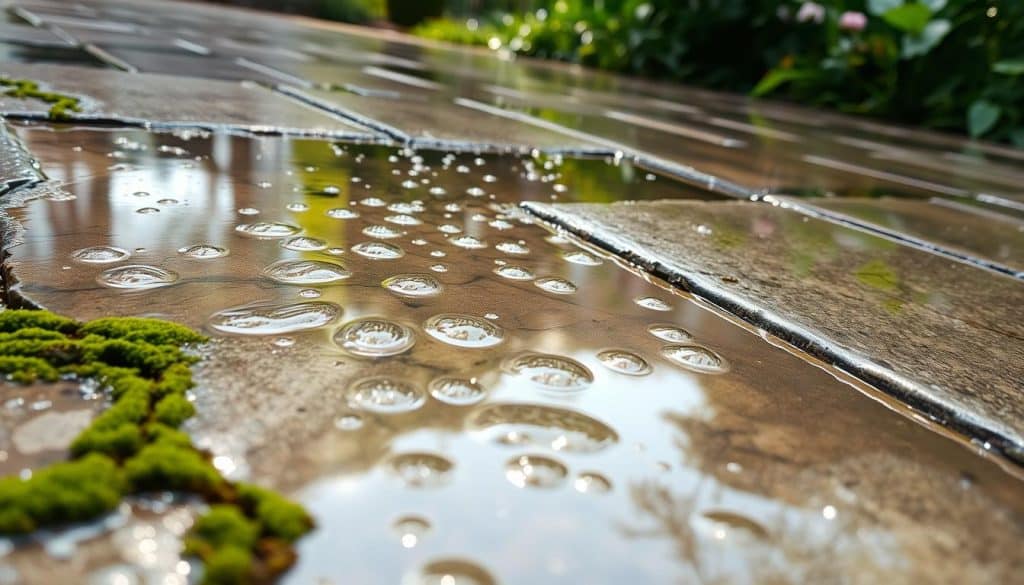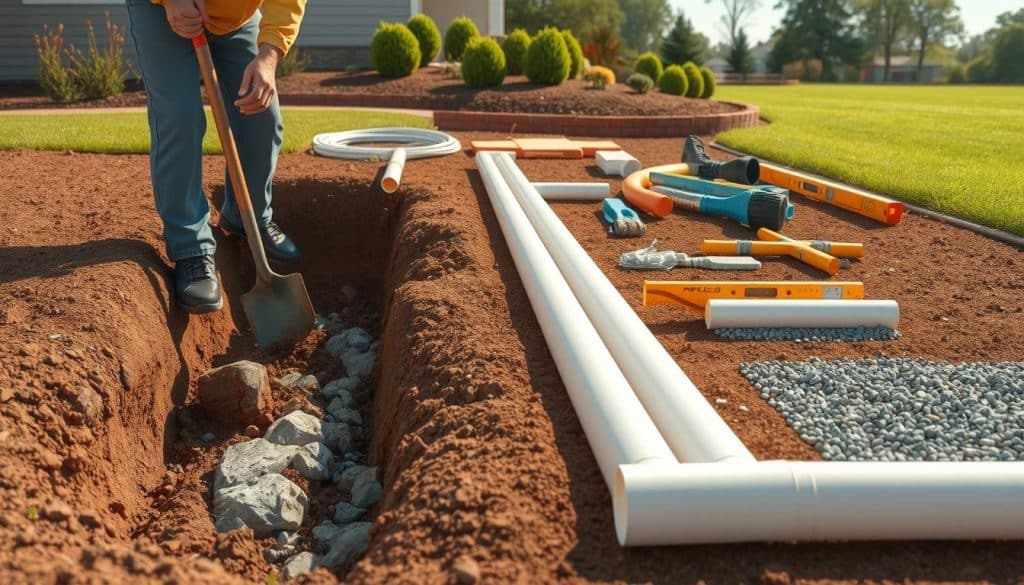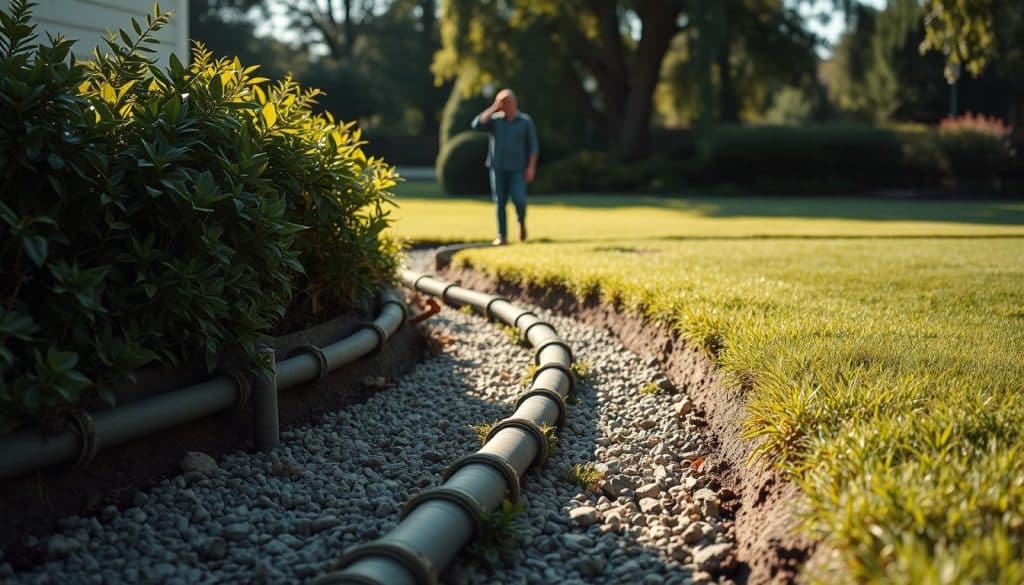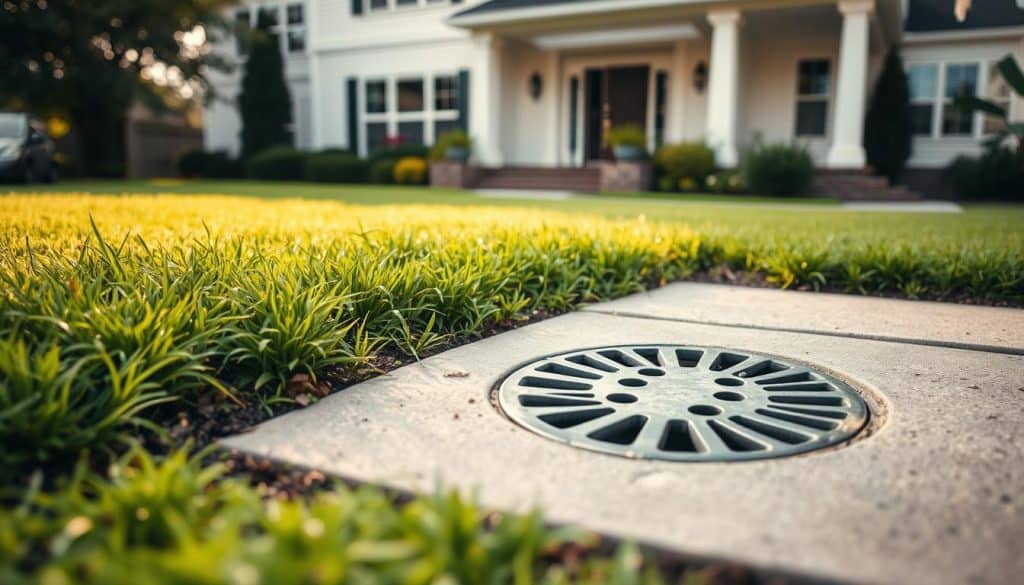Table of Contents
What if the secret to protecting your home from costly water damage is hidden beneath your feet? Is French Drain Installation Necessary for My Home? French drain installation is key for homeowners wanting to control moisture and protect their foundations.
Water pooling, mold, or damp basements can harm your property’s integrity. Let’s look into what a French drain is and how it works. You might find it’s essential for stopping water damage and boosting your home’s value.



Key Takeaways
- French drains are designed to redirect surface water away from your home.
- Installation costs can range from $10 to $50 per linear foot, with deeper systems costing more.
- Installing a French drain during home construction is more efficient than retrofitting one later.
- Proper maintenance, including regular inspection and cleaning, is essential for optimal performance.
- A French drain installation can prevent costly basement water damage.
- In areas with heavy rainfall, a French drain is a critical preventative measure.
- Understanding zoning restrictions is vital before installation.
Understanding French Drains
A French drain is a key part of an exterior drainage system. It helps keep foundations safe from water damage. It moves water away from areas that could be damaged, keeping buildings strong and preventing erosion. It works by using a few important parts. These parts help move water away from homes. This keeps the environment safe around buildings.What is a French Drain?
A French drain is a trench filled with gravel and a perforated pipe. It helps move water away from buildings, keeping foundations safe. Henry French introduced this idea in 1859 to help with farming and prevent floods.Key Components of a French Drain
The main parts of a French drain are the trench, gravel, perforated pipe, and filter fabric. Each part is important for the system to work well. The gravel helps water flow and keeps the pipe clean. For DIY projects, the trench should be about 18 inches deep and 12 inches wide. This size is key for the system to work right.How Do French Drains Work?
French drains work by moving water away from buildings. Water collects in the trench, then flows through the gravel and into the pipe. It then goes to places like ditches or dry wells. It’s important to have a slope of one inch for every eight feet towards the drain. This helps water move away from foundations. It keeps buildings safe from water damage and costly repairs.
Signs Your Home Needs a French Drain
Homeowners need to know when their home needs a French drain. Water gathering around the foundation can damage your home over time. This problem often shows up after it rains, showing that your home’s drainage isn’t working well. It’s important to fix this problem quickly to avoid bigger issues.Persistent Water Accumulation
Water that keeps coming back in your yard might mean your home needs a French drain. This water not only looks bad but can also harm your home’s structure. Standing water can weaken your foundation, so you need to act fast.Frequent Mold Growth
Mold is a big problem for homeowners. Places that are damp, like basements or crawl spaces, are at risk. Moisture makes mold grow fast, so a French drain is key to stop it. Stopping mold keeps your family healthy and your home safe.Musty Odors in Basements or Crawl Spaces
Don’t ignore musty smells in basements or crawl spaces. These smells mean there’s too much moisture in your home. If you don’t fix this, you could get sick from mold. Getting a French drain helps get rid of these bad smells and makes your home safe.Benefits of Installing a French Drain
Installing a French drain has many benefits for homeowners. It helps manage water well, preventing damage and protecting your home’s foundation for years.Preventing Water Damage
A French drain keeps water away from your home. It manages moisture, cutting down basement flooding by 50% in homes with water problems. This means less worry and fewer expensive repairs for you.Reducing Mold Risks
Too much moisture is bad for mold, which harms your health. A French drain helps keep your basement dry, lowering humidity and mold risks. This makes your home healthier and stronger.Enhancing Home Value
Getting a French drain can boost your home’s value by up to 10%. It improves drainage and reduces damage risks. This makes your home look better and more valuable in the market.Different Types of French Drains
It’s important to know about the different French drains for good water management at home. Each type is made for a specific need and tackles various drainage problems. Think about where you need it, how water flows, and how easy it is to install.Interior French Drains
Interior French drains go around your basement floor to handle water that’s already inside. They’re less invasive than exterior drains, perfect for homes that already exist. You might need to break through concrete, but they’re less likely to clog. It’s key to keep the sump pump working well to make sure these drains do their job.Exterior French Drains
Exterior French drains are set up around your foundation to keep surface water away. They’re good for areas with lots of water and can be a bit hard to install. You might need to remove landscaping or concrete. Even though they’re good at stopping water damage, they can get clogged by sediment over time.Channel Drains
Channel drains, or trench drains, sit on the surface to catch and move water outside. They’re great for places that flood easily. You can find them in materials like polymer concrete and stainless steel, fitting both homes and businesses.The French Drain Installation Process
Homeowners should know about the French drain installation process. It’s a way to prevent water damage and flooding. The process includes choosing the right materials, following steps, and setting a timeframe for the job.Types of Materials Used
The materials used in French drain installation are key to its success. Perforated PVC pipe lets water flow but keeps debris out. Gravel helps with drainage, and filter fabric stops sediment. Sometimes, a sump pump is added for better drainage in areas with high water tables.
Steps in the Installation Process
Installing a French drain needs careful planning and execution. First, pick a spot for the drain with a slope of at least 1 percent. Dig a trench that slopes down 1 inch for every 10 feet. Then, put in the perforated pipe, followed by gravel for drainage. After that, fill the trench with soil to finish the job.Timeframe for Installation
The time it takes to install a French drain varies. Professionals usually do it in a couple of days. DIY projects might take longer, depending on the complexity and site conditions. It’s important to make sure the drain is installed correctly. This includes the right depth and slope for it to work well.Common Misconceptions About French Drains
Many homeowners have misconceptions about French drains. These myths can stop people from making smart choices about their drainage needs. It’s important to know the truth about these systems.“French Drains Are Only for Flood-Prone Areas”
Some think French drains are only for homes in flood-prone areas. But this is not true. They can help any home with water problems, no matter the flooding history. Installing a French drain can prevent water damage.“Once Installed, They Require No Maintenance”
Many believe French drains need no upkeep after installation. This is not correct. They need regular checks and cleaning to work well. Keeping them clean prevents clogs and keeps them efficient.“They Are Too Expensive to Install”
High installation costs often scare people away from French drains. While they can cost between $1,000 and $5,000, they are worth it. They save money on repairs and damage in the long run.Cost Factors for French Drain Installation
Homeowners need to know the costs of French drains before deciding. Prices range from $1,650 to $12,250, depending on the project’s complexity and features. Different types of drains affect the total cost.Average Installation Costs
Exterior French drains cost between $10 to $75 per foot. Interior ones are pricier, at $40 to $100 per foot. The average cost is around $5,000, but it can be as low as $500 or as high as $18,000. Don’t forget about permit fees, which are $50 to $100 each. The cost of pipes is usually $50 to $200. These factors add up to the final price.Factors Affecting Price
Several factors can increase the cost of French drains. Soil conditions like heavy clay or rocky terrain might require special equipment. This raises labor costs. Accessibility issues can also make the installation more complex. Adding features like sump pumps costs $150 to $400. Landscaping to restore the yard adds more expense. The cost of gravel or stone for installation is $500 to $1,000, affecting the total cost.Benefits vs Cost Analysis
It’s important to weigh the benefits against the cost of French drains. The initial cost might seem high, but it can save homeowners thousands in the long run. A well-installed French drain lasts 30 to 40 years, providing long-term moisture control.DIY vs Professional French Drain Installation
Homeowners often debate whether to install a French drain themselves or hire a pro. DIY can save money, letting you handle the materials and work. You can do a DIY job for under $1,000, which is great for shallower drains.Pros of DIY Installation
DIY installation can save a lot of money. It can cost much less than hiring a pro, which can be $1,000 to $9,000. You get to pick your materials and make it fit your needs. If you’re skilled, it can boost your home’s value and feel rewarding.Risks of DIY Installation
DIY has its downsides. It might not drain water properly, making water problems worse. Not following the right slope can also cause issues. Make sure you know what you’re doing before starting, as mistakes can be expensive.When to Hire a Professional
There are times when you should get a pro. If your drainage problem is complex or involves your foundation, you need an expert. Pros offer warranties, ensuring your drain works well for years. If you’re unsure about DIY, it’s safer to hire a pro to avoid problems.Choosing the Right Company for Installation
Finding the right company for French drain installation is key to fighting water damage. Homeowners should pick Array of Solutions for reliable solutions. This company, founded in 2007, is known for quality and expertise.Why Choose Array of Solutions?
Array of Solutions focuses on professional installation. They use certified mold inspectors and skilled technicians. Their experience in South Carolina makes them a top choice for homeowners. They offer customized solutions that fit individual needs.Certifications and Experience
Array of Solutions has certifications from the Environmental Protection Agency (EPA). This shows they are trustworthy and skilled. Their team works hard to provide excellent service that meets industry standards.Customer Testimonials
Many customers have shared positive experiences with Array of Solutions. Their satisfaction and reliability add to the company’s good name. For more info, visit the Array of Solutions website.Other Solutions for Moisture Control
There are many ways to keep your home safe from water damage. Using dehumidifiers and ventilation systems can lower humidity, making your home healthier. Waterproofing your home, like sealing foundation walls, also helps keep moisture out. Landscaping is key too. It helps direct water away from your home. This keeps your foundation dry and safe.Dehumidifiers and Ventilation Systems
Dehumidifiers are great for keeping humidity levels right. They pull moisture from the air, which helps prevent mold and other moisture problems. Good ventilation systems also help by keeping air moving, stopping humidity from building up in places like basements and attics.Waterproofing Techniques
Waterproofing is important for protecting your home from water damage. You can use sealants, install sump pumps, and put up vapor barriers. These steps help keep moisture out, making your home safer and last longer.Landscape Grading Solutions
Landscape grading changes your yard’s slope to help water drain away. This makes sure water doesn’t pool near your home. It’s a smart way to protect your foundation and make other moisture control methods work better.Contact Us for Your French Drain Needs
If you’re dealing with constant drainage problems at home, contacting Array of Solutions is a smart move. Our team is expert in French drain installation and quick mold inspections. We know how important it is to act fast, given the heavy rainfall in places like Pennsylvania and Southern California. To reach us, just call (864) 710-6413 or email scmoldremoval@gmail.com.Get in Touch with Array of Solutions
We offer detailed mold inspection services. Homeowners can book inspections usually within 24 hours. Keeping your home dry and free from moisture is our main goal. Our experts will help you find the best solutions for your drainage issues. We promise top-notch service from start to finish. Don’t wait; protect your home now.Our Commitment to Quality Service
Array of Solutions stands out because of our dedication to quality. We take great care in every installation and keep you updated every step of the way. Our experienced team will make sure your French drain works perfectly. This will keep your home healthy and free from mold and water damage. Contact Array of Solutions to make your home safer.
FAQ
Is French drain installation necessary for all homes?
Yes, it’s a must for homes with water pooling, moisture issues, or mold. It’s key in rainy or flood-prone areas. It controls moisture and protects the foundation.
What are the key components of a French drain?
A French drain has a trench, gravel, a perforated pipe, and filter fabric. These parts work together to move water away from your home’s foundation. This prevents damage and boosts your home’s value.
How do French drains operate to prevent water damage?
French drains collect water in a trench. The water flows through gravel and into a pipe. This pipe directs the water away from your home, stopping moisture buildup and damage.
What signs indicate that my home might need a French drain?
Signs include water around the foundation, mold in basements or crawl spaces, and musty smells. These signs mean trapped moisture, which can harm your home.
What are the primary benefits of installing a French drain?
The main benefits are preventing water damage, stopping mold growth, and increasing your home’s value. French drains are vital for protecting your home’s foundation.
What types of French drains are available for installation?
There are three types: interior, exterior, and channel drains. Interior drains go around the basement. Exterior drains are by the foundation. Channel drains catch outdoor runoff.
What materials are used in the French drain installation process?
Materials include PVC pipe, gravel, filter fabric, and sometimes sump pumps. These are key for managing water effectively.
How long does the French drain installation process typically take?
It usually takes a couple of days, depending on the site. Professional installation ensures it’s done right.
Are there misconceptions about French drains that homeowners should be aware of?
Yes, some think they’re only for flood areas. But they help with any water issues. Also, they need regular checks and cleaning to work well.
Should I consider a DIY approach for French drain installation?
DIY can save money but risks poor installation and bad drainage. It’s safer to hire pros, even if it costs more.
Why is it important to choose a reliable company for French drain installation?
A good company, like Array of Solutions, offers quality service and expert installation. They have certifications and great reviews, showing their dedication to workmanship.
What alternative solutions are available for moisture control in homes?
You can use dehumidifiers, ventilation systems, waterproofing, and landscape grading. These methods help manage moisture and protect your home from water damage.
How can I get in touch with Array of Solutions for French drain installation?
Call Array of Solutions at (864) 710-6413 or email scmoldremoval@gmail.com for help with French drains or mold inspections. They offer quick service and support.

